Dolmen › Domitian › Women in Ancient Greece » Origins and History
Articles and Definitions › Contents
- Dolmen › Origins
- Domitian › Who Was
- Women in Ancient Greece › Origins
Ancient civilizations › Historical places, and their characters
Dolmen › Origins
Definition and Origins
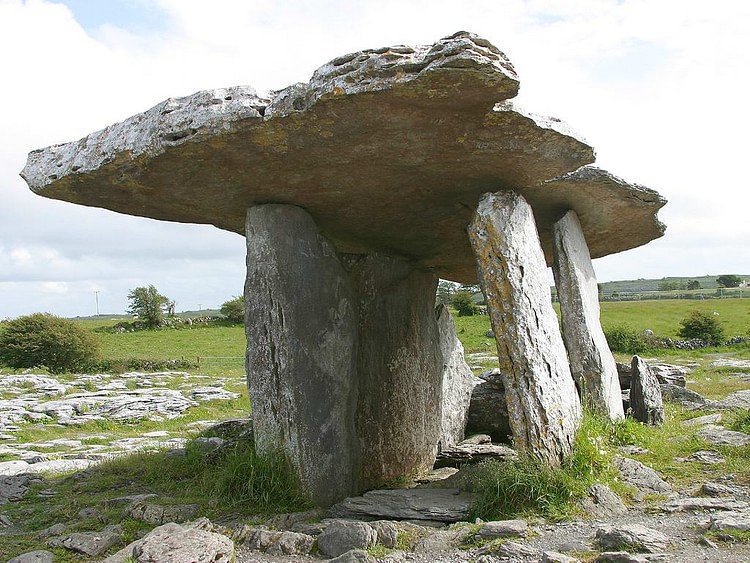
A dolmen is a megalithic structure typically formed from a large horizontal stone slab resting on two or more upright slabs.The oldest European examples are found in Brittany, northern France, and date to the 5th millennium BCE. Dolmens are also present in the Middle East, North Africa, Asia, and especially large numbers exist in Korea, with examples there dating to c.1000 BCE. The structures functioned as burial chambers or as sites of ancient cult worship, for example to an earth or fertility goddess.
NAMING
Megalithic architecture, specifically the construction of sanctuaries and tombs using enormous blocks of stone, occupies an important position in the cultural experience of Prehistory. The word dolmen, which derives from Breton t(d)aol meaning table and men or min meaning stone, appears in the scientific debate around the end of the 1700s CE. Until that time the examination of these “strange” monuments, scattered here and there, gave way to suppositions that were, to say the least, fanciful. It was thought they were works built by giants or, indeed, deeds of the devil. The first investigations were, therefore, to understand the use of these structures and establish their age, even though the absence of metal objects indicated the period they could belong to.
PRELIMINARY INVESTIGATIONS
In the second half of the 1800s CE, the publication of the first European map of the known megalithic localities highlighted so many coincidences that it led to the belief that they were the work of one unique population. Therefore it seemed justifiable to consider the “megalithic phenomena” an unusual cultural manifestation of the Near East and dolmens, in definition, the unnatural reproduction of the Mediterranean burial grotto.
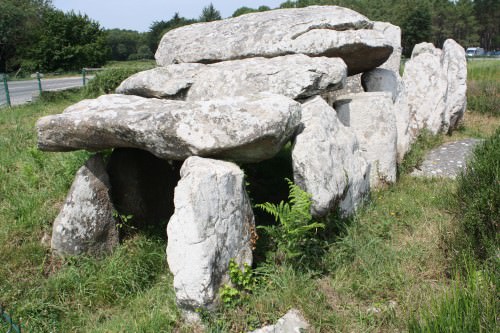
Kermario Dolmen, Carnac
The Australian archaeologist V. Gordon Childe reinforced this hypothesis in his last book The Prehistory of European Societywhere he claimed that the construction of the enormous mausoleums was carried out by mythical megalithic missionaries, members of some early Aegean tribes from the eastern Mediterranean, who divulged a religious faith known to belong to the cults of Gaia the Mother Goddess, goddess of the earth.
DATING
The perfection of absolute dating systems, thanks to the 14C radio-carbon method, put an end to this thesis once and for all. It was proven that the oldest megalithic tombs originated in central/northern Europe. Breton dolmens date back to 4500 BCE (earlier, therefore, than the Egyptian pyramids, Mesopotamian ziggurats and the great Cretan and Mycenae sites). They spread further south to central and southern France, south-west to Spain and Portugal and north-east to the central lowlands of Europe, Sweden and so on. They concluded their phase with the most recent constructions in Malta, around 2400 BE and in Italy at the beginning of the 2nd millennium BCE.
INESTIMABLE PROBLEMS HAD TO BE FACED SUCH AS FINDING SUITABLE STONES & THEN TRANSPORTING THEM.
The above time range was sufficient for each region to evolve a local typology though keeping a common characteristic: the use of blocks or slabs of stone, at times colossal in dimension, which made them phenomena tied to a fairly widespread culture.
The Mediterranean dolmens are to be dated back to an era closer to ours. Around 100 can be found throughout Sardinia, some of which, the so-called dolmen cysts made up of stone slabs assembled in a cubiform manner, are dated back to the Copper Age, around 3000-2100 BCE. Dolmens in southern Italy, which are more recent, date back to the first half of the 2nd millennium BCE, the period corresponding to the latter phase of the Bronze Age.

Dolmen, Gochang, Korea
Outside of Europe, the most frequent occurrence of dolmens is in the Korean peninsula where there are some 200,000 megalithic structures. Korean dolmens are remarkably similar to those found in Europe. Finds excavated from within many of the dolmens illustrate that they were typically used for elite burials. Unusually, Korean dolmens were sometimes built in close proximity to each other, creating cemetery-like areas consisting of between 30 and 100 structures.
PRINCIPAL CHARACTERISTICS
The most elementary configuration of the dolmen is trilithic: a horizontal slab of stone placed on top of two vertically positioned stones in order to form a construction where the structural elements frame a quadrangular space. Such forms can be found just about anywhere, in Iceland, Scotland, England, North Germany, France, Spain, Scandinavia, Denmark, Holland, Corsica, Sardinia, Apulia, Sicily, Malta, North Africa, Morocco, Tripoli, Egypt, Syria, Palestine, Bulgaria, Crimea, Caucasus, Iran, India, Korea.
More complex forms which were made up of a long or even longer succession of triliths followed, so generating two particular types: the corridor tomb and the gallery tomb ( allée couverte ). The corridor tombs, made of big slabs of stone vertically fixed into the ground (orthostats), have corridors that vary in length and lead to a chamber or a number of chambers of a polygonal shape. The gallery tombs, instead, have just one rectangular-shaped space used entirely as a sepulchral chamber.

Elementary Configuration of a Dolmen
Some of these structures evolved into rather complicated constructions, as in the case of the false dome dolmens where the convex roof was obtained by gradually decreasing the distance between the slabs of the building. Another instance is that of the dolmens with lateral chambers; characterised by a series of cells around the central one. Each sepulchre, or series of sepulchres, was completed by being covered with earth mixed with stones.
Inestimable problems had to be faced in whichever region they were built such as finding suitable stones and transporting the material for construction. In those areas where the stone was extremely hard and difficult to shatter, they raised enormous monuments; whereas, in other places where the stone was easy to chip, dry-stone method structures were built rather than using the real megalithic technique. This is the case of the small Sicilian dolmens.
To the south, the islands of Malta and Gozo are home to the most extraordinary prehistoric sites of the Mediterranean, the “megalithic temples”. They were built between about 4000 and 2500 BCE. They were dedicated to a cult worshipping a fertility goddess. The dolmens, as they should be correctly called, (around 20 in all) are to be dated back to a successive period (the second half of the 3rd millennium BCE). In most cases, we are dealing with small chambers, with the cover made of a large slab placed on upright stones. They are claimed to belong to a population certainly different from that which built the previous megalithic temples.

The Dolmen of Monte Bubbonia
Not all megalithic stone structures were funeral monuments: the cromlechs of Stonehenge in England and the Carnacmenhirs in France, to mention some, would have served other extraordinary purposes, perhaps connected to the practice of an astronomy cult. They could have represented the product of a culture that sought to capture the irradiation centre of absolute positive energy in the universe. The “prototype” of this architecture almost certainly had its origins in a series of lucky coincidental factors - the natural occurrence of fallen stones or some suggestive natural “scenery” must have let loose the religious imagination of certain prehistoric communities. So much so, an exceptional mystic significance was given to the stones.
Domitian › Who Was
Definition and Origins
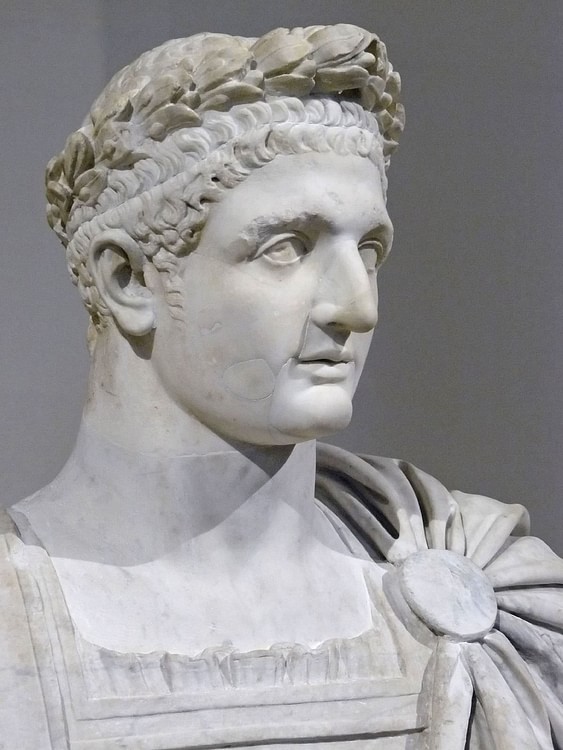
Domitian was Roman Emperor from 81 to 96 CE and his reign, although one of relative peace and stability, became engulfed in both fear and paranoia. His death at the hands of those who were closest to him brought an end to the short dynasty of the Flavians and it was those emperors who would follow, at least for the next one hundred years, who would see a rebirth of some of the grandeur and power of old Rome.
EARLY LIFE
Titus Flavius Domitianus, Domitian, was born October 24, 51 CE on Pomegranate Street in the sixth district of Rome, youngest son of the future emperor Vespasian (64 -79 CE); his mother, Flavia Domitillia Major, died in his youth. Unlike his much older brother, Titus, he did not share in the court education, although many considered him bright. According to historian Suetonius, his “rather degraded youth” was spent in poverty. In December of 69 CE while Vespasian was battling in the eastern provinces in an attempt to secure the throne away from Emperor Vitellius, Domitian was in Rome with his uncle Flavius Sabinus. When Vitellius's forces besieged Rome and set fire to the temple where Domitian was hiding, he was able to escape with a friend across the Tiber to safety.
When Flavian forces entered the city, Domitian returned to Rome becoming, albeit temporarily, the representative of the Flavian family; he was even hailed by Roman citizens as “ caesar ”; however, most of the administrative decisions were left to others. Vespasian returned to the city in October of 70 CE and was immediately hailed as the new emperor. Afterwards, although given titles and honours, Domitian never sought any real responsibility and was given little by either his father or later his brother, a poor preparation for a future emperor.
HE WAS TREACHEROUS AS WELL AS SECRETIVE, FEELING NO AFFECTION FOR ANYONE (EXCEPT WOMEN).
A POPULAR EMPEROR
His ascension to the throne came on September 14, 81 CE when Titus died of natural causes while he and his brother were travelling outside Rome. Later, rumours circulated that Domitian may have had a hand in his brother's death, possibly by poison. Gossip also ran rampant that the new emperor had at one point even plotted to overthrow his brother and take the throne for himself. Whether or not he had a hand in Titus's death, Domitian did not wait for his brother to die. He quickly returned to Rome and the Praetorian camp to be proclaimed emperor. Mystery, however, surrounded the last minutes before Titus's death. There is some disagreement on the meaning of Titus's last words: “I have made but one mistake.” Suetonius wrote he “gazed up at the sky, and complained bitterly that life was being undeservedly taken from him, since a single sin lay on his conscience.” He added, “… this enigmatic remark has been taken as referring to incest with Domitian's wife, Domitia, she herself solemnly denied the allegation.” Suetonius did not believe this was the case because if she had had an affair, she would have bragged about it. Some, those not overly fond of the new emperor, took a more negative view of these words - Titus meant he should have killed Domitian when he had the chance.
Early in his reign, Domitian proved to be an able administrator and did not ignore the welfare of the people. Before the Flavians came to power, much of Rome needed rebuilding, mostly due to fire, decay, and the failure of previous emperors to do anything about it. He restored the gutted ruins of many public buildings, including the Capitol which had burned in 80 CE, built a new temple to Jupiter the Guardian, a new stadium, and a concert hall for musicians and poets. For himself, because he didn't like the old imperial palace, he built a new Flavian Palace on Palatine Hill for official functions, and to the south he constructed the Domus Augustana where he held numerous banquets and receptions. Despite his own lack of moral values, he attempted to raise the standards of public morality by forbidding male castration, admonishing senators who practiced homosexuality, and censuring the Vestal Virgins for, among other indiscretions, incest - one was even buried alive (her lover was also executed). By those around him, at least early in his reign, he was viewed as being generous, possessing self-restraint, considerate of all of his friends, and conscientious when dispensing justice.
Domitian also liked games, in particular, chariot races, even adding two new factions - Golden and Purple. In fact he loved public entertainments of any kind, especially those involving women and dwarves. There were also wild beast hunts and gladiatorial contests by torchlight and there were competitions to the death between infantry and cavalry. The basement of the Colosseum (built by his father) was flooded and used for a naval battle. He even founded a festival of music, horsemanship, and gymnastics that was to be held every five years. However, while both Domitian and the public enjoyed these entertainments, their cost would eventually take a heavy toll on his and the empire ’s finances.
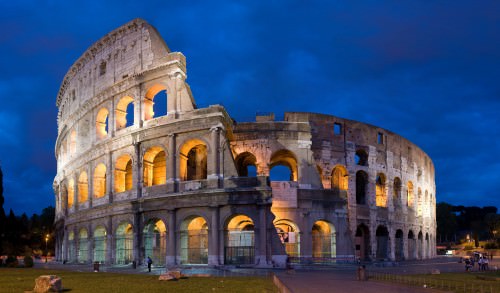
The Colosseum of Rome
Although not a military man (unlike Vespasian and Titus), he considered himself one and constantly sent messages to the generals in the field with advice and recommendations. Having no personal experience himself and hoping to claim some credibility with the army, he embarked on a victorious campaign to Germany to engage the Chatti in 83 CE. Afterwards, he awarded himself the title of Germanicus for his “success.” In 85 CE the Dacians crossed the Danube onto the northern frontier, killing a Roman commander. Four years later, the Roman army won another decisive victory at Tapae; however, Domitian was forced reluctantly to conclude a truce with King Decebalus. In 92 CE, the Samatians crossed the Danube and attacked the Roman frontier, a war that would endure until after the emperor's death. Despite the results of his military achievements, he earned the respect of the army when he became the first emperor since Augustus to give them a raise.
THE PARANOID EMPEROR
In his The Twelve Caesars Suetonius claimed that Domitian was not evil to begin with; however, greed and fear of assassination made him cruel. Historian Cassius Dio in his Roman History said the emperor was both bold and quick to anger.He was treacherous as well as secretive, feeling no affection for anyone (except women). He was extremely vain and very self-conscience of his being bald. As his reign progressed and the pressures of ruling mounted, his paranoia seized him. In order to pay for his extravagances he tightened the Jewish tax enacted by his father and seized the fortunes of senators and wealthy Romans. His paranoia even extended to his wife, Domitia Logina. He accused her of adultery (some accounts claimed she deserved it) and planned to put her to death, a common practice for the time. Domitia had been married to a senator, Aelius Lamia, but he was convinced to divorce her so she could marry Domitian. Domitian temporarily left his wife to live with his niece Julia, Titus's daughter by his second marriage, until he was convinced by others to return to his wife.
The emperor saw himself as an absolute ruler and took pride in being called master or god: “ dominus et deus.” He even renamed two of the months after himself - Germanicus (September) and Domitianus (October). The Senate was almost stripped entirely of its power and his paranoia led to the execution of both senators and imperial officers for the most trivial of offences. Out of jealousy, he had Sullustius Lucullus, governor of Britannia, executed for naming a new type of lance after himself and he recalled Agricola, a victorious general in Britain because he became too popular.
In his book On Britain and Germany Tacitus recounted the tenuous relationship between Agricola and Domitian. The general's victories in Britain put the emperor in a precarious position as he was torn between pride for a Roman victory (and keeping up appearances to the public) and jealousy because of his own failure as a commander. “Agricola…was received by Domitian with the smile on his face that so often masked a secret disquiet. He was bitterly aware of the ridicule that had greeted his sham triumph over Germany….”. Upon returning to Rome, the general was offered the governorship of Syria but refused. His death at the young age of fifty-four, again, put Domitian in a difficult position. “Domitian made a decent show of genuine sorrow; he was relieved of the need to hate, and he could always hide satisfaction more convincingly than fear.”

Roman Emperor Domitian
His paranoia led him to take extreme measures such as employing informers. As a means to obtain information on possible plots or rebels, he ordered interrogators to cut off the hands (or scorched the genitals) of prisoners. He lined the gallery where he took his daily walks with highly-polished moonstone so that it reflected everything behind him. He executed another niece's husband Flavius Clemons on the charge of atheism because he was sympathetic to the plight of the Roman Jews. However, plots against the emperor did exist. In September of 87 CE several senators were implemented in a conspiracy and were executed and a mutiny by Lucius Antonius Saturninus, governor of Upper Germany, in 89 CE was stamped out.
DEATH
The final conspiracy against his life, however, was successful - a plot that even suggested the approval of Domitia herself (she remained fearful of her life.) According to Suetonius and others, a group of conspirators (they had heard their names were on a “list”) were debating on whether to assassinate the emperor in his bath or at dinner. Stephanus, a member of Domitian's imperial staff (he had been accused of embezzlement and feared for his life) approached the conspirators, offering his services. For several days he faked an arm injury and wore a protective wrapping; however, the bandage concealed a dagger.Approaching Parthenius, Domitian's valet, he said he had a list of possible conspirators and as Stemphanus approached the emperor, he pulled out the dagger and stabbed the unsuspecting Domitian in the groin. The two men struggled with Domitian reaching for the knife he kept under his pillow but Parthenus had removed the blade. Then other conspirators hurried into the room and hacked the emperor to death. He was only forty-four years old. His ashes were taken by his old nurse Phyllus and interred in the Temple of Flavian.
On hearing of his death the Senate was overjoyed. Suetonius wrote, “The Senators, on the other hand, were delighted and thronged to denounce Domitian in the House with bitter and insulting cries. Then, seeking for ladders, they had his images and the votive shields engraved with his likeness, brought smashing down….” Immediately, Marcus Cocceius Nerva was hailed as the new emperor - a temporary fix until someone better could be found. In the months that followed, the city celebrated the death of the old emperor by turning over his statues and ceremonial arches, however, the Praetorian Guard would not take the assassination lightly and eventually many of the conspirators would meet their own deaths.
Women in Ancient Greece › Origins
Ancient Civilizations
Women in the ancient Greek world had few rights in comparison to male citizens. Unable to vote, own land, or inherit, a woman's place was in the home and her purpose in life was the rearing of children. This, though, is a general description, and when considering the role of women in ancient Greece one should remember that information regarding specific city -states is often lacking, is almost always from male authors, and only in Athens can their status and role be described in any great detail. Neither are we sure of the practical and everyday application of the rules and laws that have survived from antiquity. We do know that Spartan women were treated somewhat differently than in other states. For example, they had to do physical training like men, were permitted to own land, and could drink wine.
There were also categories of women which are less well-documented than others such as professional women who worked in shops and as prostitutes and courtesans; the social rules and customs applied to them are even more vague than for the female members of citizen families. Finally, in contrast to the lot of most women, some exceptionally and exceptional, rose above the limitations of Greek society and gained lasting acclaim as poets ( Sappho of Lesbos ), philosophers (Arete of Cyrene ), leaders ( Gorgo of Sparta and Aspasia of Athens), and physicians (Agnodice of Athens).
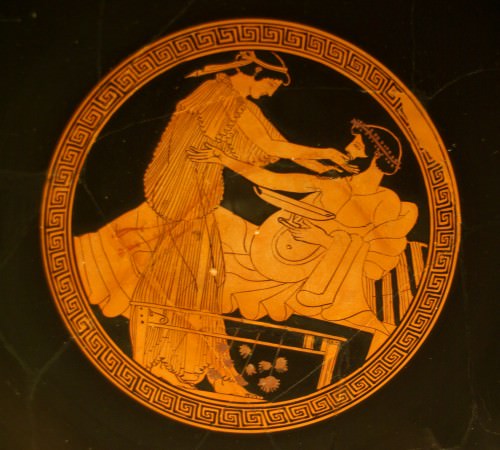
Symposiast & Hetairai
WOMEN IN MYTHOLOGY
Considering their limited role in actual society there is a surprisingly strong cast of female characters in Greek religion and mythology. Athena, the goddess of wisdom and patron of Athens stands out as a powerful figure blessed with intelligence, courage and honour. Again common to most ancient cultures where agriculture was crucial to the community, female fertility goddesses were extremely important and particularly venerated - Demeter and Persephone being the most revered for the Greeks.
As in other ancient male-dominated literature, women are often cast as troublemakers, from jealous Hera to Aphroditeemploying her charms to make men lose their wits. Myths and literature abound with female characters trying their best to derail the plans of male heroes, from the supreme witch Medea to the deadly, if lovely, Sirens. They can also be represented as ruled only by wild passion and ecstatic emotion such as the Maenads. In contrast, the ideal chaste woman loyal to her absent husband is epitomised by Penelope in Homer ’s Odyssey. The Muses are another positive representation, celebrated not only for their physical beauty but also their wide-ranging skills in the arts. Whether these fictional characters had any bearing on the role of women in real life is an open question, as is the more intriguing one of what did Greek women themselves think of such male-created role-models? Perhaps we will never know.
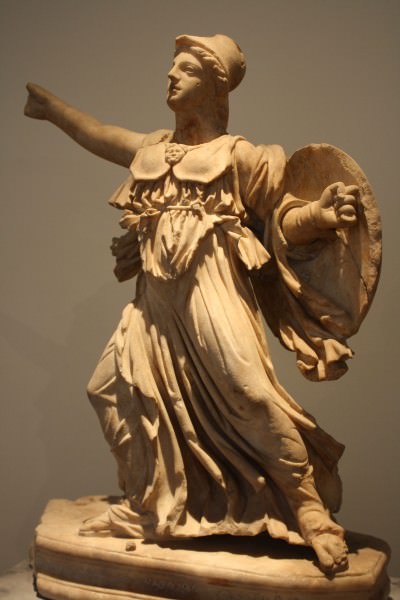
Athena (after the East pediment of the Parthenon)
GIRLS
As in many other male-dominated and agrarian cultures, female babies were at a much higher risk of being abandoned at birth by their parents than male offspring. Children of citizens attended schools where the curriculum covered reading, writing, and mathematics. After these basics were mastered, studies turned to literature (for example, Homer), poetry, and music (especially the lyre ). Athletics was also an essential element in a young person's education. Girls were educated in a similar manner to boys but with a greater emphasis on dancing, gymnastics, and musical accomplishment which could be shown off in musical competitions and at religious festivals and ceremonies. The ultimate goal of a girl's education was to prepare her for her role in rearing a family and not directly to stimulate intellectual development.
THE GOAL OF A GIRL'S EDUCATION WAS TO PREPARE HER FOR HER ROLE IN REARING A FAMILY & NOT TO STIMULATE INTELLECTUAL DEVELOPMENT.
An important part of a girl's upbringing involved pederasty (it was not only practised by mature males and boys). This was a relationship between an adult and an adolescent which included sexual relations but in addition to a physical relationship, the older partner acted as a mentor to the youth and educated them through the elder's worldly and practical experience.
YOUNG WOMEN
Young women were expected to marry as a virgin, and marriage was usually organised by their father, who chose the husband and accepted from him a dowry. If a woman had no father, then her interests (marriage prospects and property management) were looked after by a guardian ( kyrios or kurios ), perhaps an uncle or another male relative. Married at the typical age of 13 or 14, love had little to do with the matching of husband and wife ( damar ). Of course, love may have developed between the couple, but the best that might be hoped for was philia - a general friendship/love sentiment; eros, the love of desire, was often sought elsewhere by the husband. All women were expected to marry, there was no provision and no role in Greek society for single mature females.
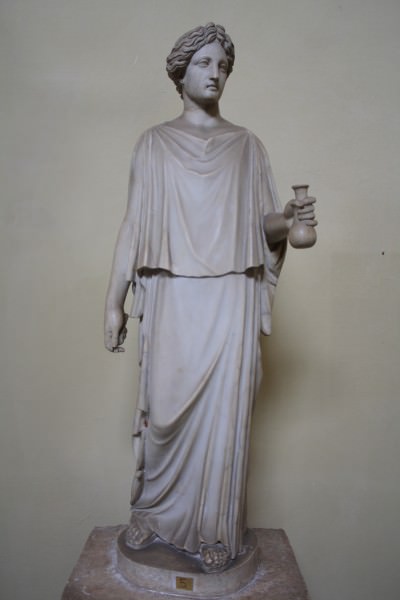
Greek Peplos Dress
MARRIED WOMEN
In the family home, women were expected to rear children and manage the daily requirements of the household. They had the help of slaves if the husband could afford them. Contact with non-family males was discouraged and women largely occupied their time with indoor activities such as wool-work and weaving. They could go out and visit the homes of friends and were able to participate in public religious ceremonies and festivals. Whether women could attend theatre performances or not is still disputed amongst scholars. More clear is that women could not attend public assemblies, vote, or hold public office. Even a woman's name was not to be mentioned in public – for good reasons or bad.
Married women were, at least in the eyes of the law, under the complete authority of their husbands. Such writers as Aristotlehave no doubts that women were intellectually incapable of making important decisions for themselves. In practice, of course, individual couples may well have shared their lives more equitably. Women were expected to be faithful to their husbands, but the reverse was not the case as husbands could freely engage the services of prostitutes, live-in lovers, and courtesans. Any woman who did not preserve the honour of the family (and so protect the legitimacy of the male line) was guilty of the serious crime of moicheia which would lead to her being banned from practising in public religious ceremonies. A husband who discovered that their wife was engaging in sexual relations with another man could murder the lover without fear of prosecution.
If a woman's father died, she usually inherited nothing if she had any brothers. If she were a single child, then either her guardian or husband, when married, took control of the inheritance. In some cases when a single female inherited her father's estate, she was obliged to marry her nearest male relative, typically an uncle. Females could inherit from the death of other male relatives, providing there was no male relative in line. Women did have some personal property, typically acquired as gifts from family members, which was usually in the form of clothes and jewellery. Women could not make a will and, on death, all of their property would go to their husband.
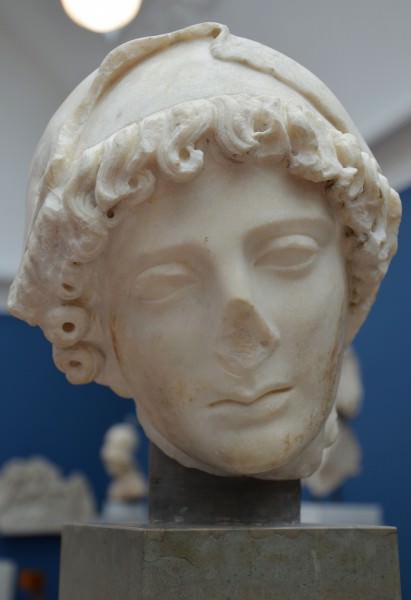
Head of Penelope
Marriages could be ended on three grounds. The first and most common was repudiation by the husband ( apopempsis or ekpempsis ). No reason was necessary, only the return of the dowry was expected. The second termination cause was the wife leaving the family home ( apoleipsis ), and in this case, the woman's new guardian was required to act as her legal representative. This was, however, a rare occurrence, and the woman's reputation in society was damaged as a result. The third ground for termination was when the bride's father asked for his daughter back ( aphairesis ), probably to offer her to another man with a more attractive dowry. This last option was only possible, however, if the wife had not had children. If a woman was left a widow, she was required to marry a close male relative in order to ensure property stayed within the family.
OTHER ROLES
Women, of course, were also present in the various other non-citizen classes. As slaves, they would have performed all manner of duties and they would also have worked in businesses such as shops and bakeries. The group for which we have most information is that of sex-workers. Women were here divided into two categories. The first and perhaps most common was the brothel prostitute ( pornē ). The second type was the higher-class prostitute ( hetaira ). These latter women were educated in music (especially the flute) and culture and often formed lasting relationships with married men. It was also this class of women that entertained men (in every sense) at the celebrated symposium, the private drinking party for male guests only.
Finally, some women participated in cults and performed as priestesses to certain female deities (Demeter and Aphrodite especially) and also Dionysos. Priestesses, unlike their male counterparts, did have the added restriction that they were often, but not always, selected because they were virgins or beyond menopause. Worshippers, on the other hand, could be both sexes, and those rituals with restrictions could exclude either men or women. The Thesmophoria fertility festival was the most widespread such event and was only attended by married women. Each year in Athens, four young women were selected to serve the priestess of Athena Polias and weave the sacred peplos robe which would adorn the cult statue of the goddess. Perhaps the most famous female religious role was the aged Pythia oracle at Delphi who interpreted the proclamations of Apollo.
LICENSE
Article based on information obtained from these sources:with permission from the Website Ancient History Encyclopedia
Content is available under License Creative Commons: Attribution-NonCommercial-ShareAlike 3.0 Unported. CC-BY-NC-SA License